Discover 50+ Snakes Found In Louisiana (7 are Venomous!)
@media (min-width: 481px) {
.mobile-top-content {
display: none;
}
}
#mobileTopContentCTACarouselControls { overflow: hidden; text-overflow: ellipsis; white-space: nowrap; }
.mobile-top-content .more { color: #fff; }
.mobile-top-content a { color: #fff; text-decoration: underline; }
.mobile-top-content a:hover { color: #fff; text-decoration: underline; }
@media (max-width: 480px) {
.mobile-top-content {
background-color: #06a10b;
color: #fff;
text-align: center;
/*height: 60px;
padding-top:5px;*/
font-size:80%;
/* display: block; */
margin: 0px -30px;
}
}
It’s probably no surprise that Louisiana has many different types of snakes. Louisiana has an extensive network of wetland swamps where snakes thrive. The warm weather and abundance of water and woods create the perfect habitat for many different types of snakes. You should always be careful when you are out in nature in Louisiana because there is a high probability that you will run across some snakes while you are out fishing, hunting, or boating. Luckily only seven of the 50-plus different types of snakes in Louisiana are venomous. Always be careful when you’re around any snake though, even if it’s not a venomous snake. Even non-venomous snakes can give you a nasty bite.
The Most Common Snakes in Louisiana
Some of the most common non-venomous snakes in Louisiana are:
Brown Snakes (Dekay’s Brown Snake)

Jay Ondreicka/Shutterstock.com
Brown snakes are very small, they are typically under 16 inches long. But you can find them almost everywhere. In Louisiana, they live in both rural and urban areas and they are often found in potted plants or under leaf piles. If there are piles of vegetation in an area there are probably brown snakes under or near it. They also live in nursery plants, so if you live in an urban area and you buy potted plants look carefully because there will probably be a brown snake in there.
Common Garter Snake

iStock.com/randimal
As the name suggests these snakes are commonly found throughout the state. They have diamond-shaped heads and patterns of spots across their bodies which they display when they feel threatened. A Common Garter Snake will lower and flatten its head and spread out its body if it is feeling cornered or threatened so if you see a Common Garter Snake start to flatten out slowly back away and leave the area.
Eastern Hog-Nosed Snake
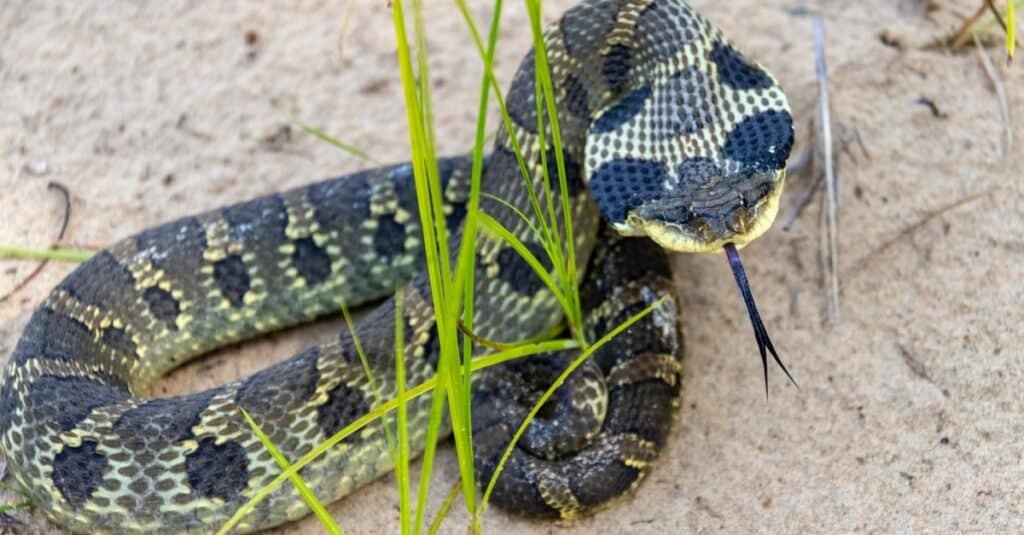
IHX/Shutterstock.com
The Eastern hog-nosed snake is another non-venomous snake that lives throughout Louisiana, although it prefers drier areas and isn’t usually found in wetlands. This snake looks pretty scary when you come across it but it’s non-venomous and it’s more scared of you than you are of it. Eastern hog-nosed snakes will look like they are going to bite if they feel threatened but it’s just a bluff. If you don’t back away immediately it will fall down and play dead until you leave the area.
Venomous (Poisonous) Snakes In Louisiana
There are only seven types of venomous snakes in Louisiana. That means you have a much higher chance of coming across a non-venomous snake than you do of running into a venomous snake. However, if you do spend a lot of time in the wet low-lying areas or in the forests you should always watch out for these venomous snakes in Louisiana:
Eastern Diamond Rattlesnake
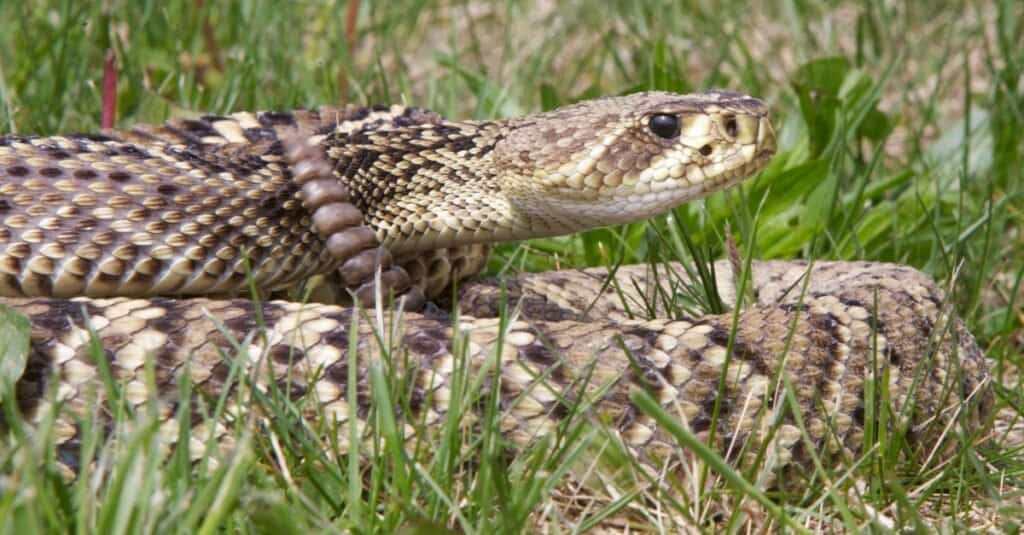
iStock.com/NajaShots
The eastern diamondback rattlesnake is one snake that you definitely cannot miss despite the muted coloring it has. The eastern diamond back is the largest and heaviest snake in Louisiana. This snake can grow to be a whopping eight feet long, although most around six feet long. The eastern diamondback is mostly nocturnal and is most active just after dusk or before sunrise.
They tend to stick to drier areas like scrublands or woodlands although they make lurk on the edges of swamps and rivers. eastern diamondbacks have a distinctive black pattern on their faces and the pattern of diamonds down their backs that they get their name from. They can strike at prey that is several feet away from them very swiftly, so you should always stay far back from one of these snakes. If you hear the telltale rattle start and you see the snake start to rise up very slowly back up until you are out of striking distance.
Timber Rattlesnake
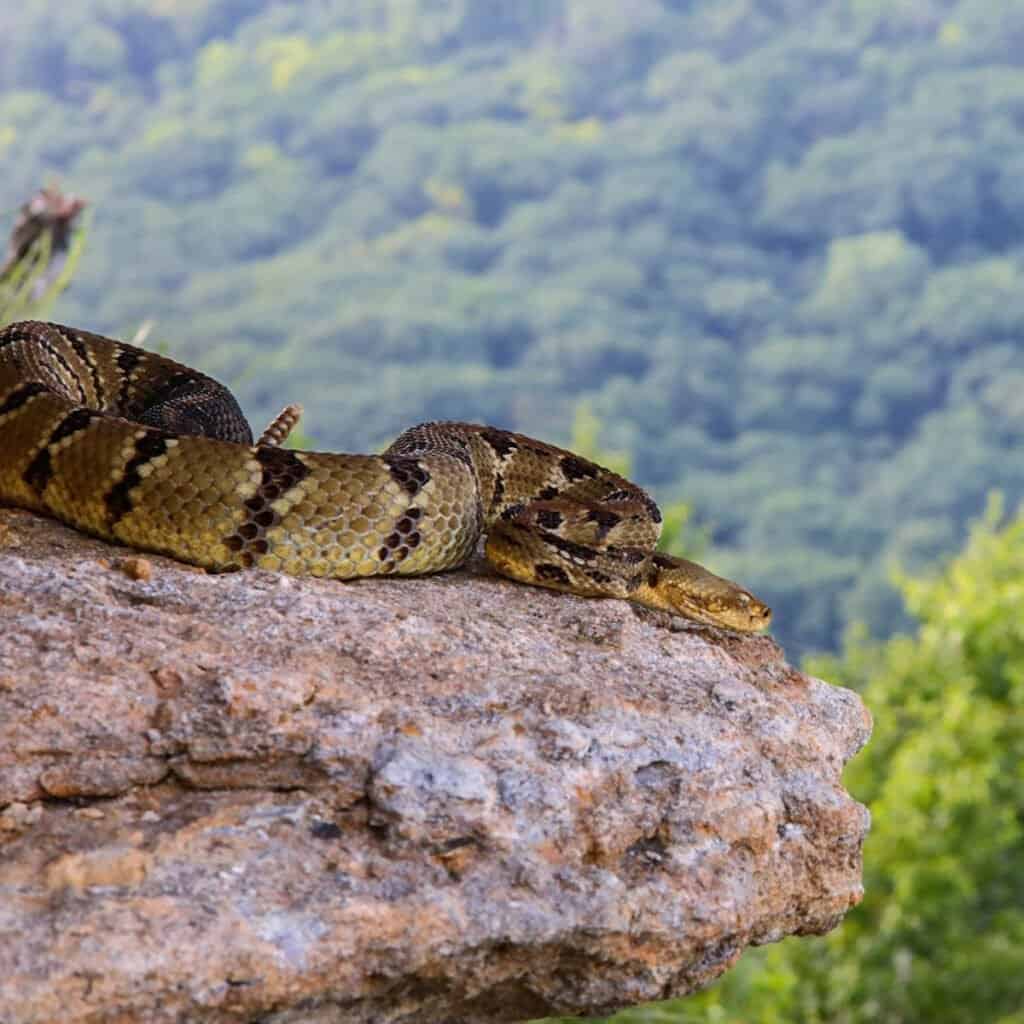
bradenjalexander/Shutterstock.com
Timber rattlesnakes inhabit forested areas, farms and agricultural areas, and lowland thickets across the entire state of Louisiana. They can get to be about five feet long and they have colorings that range from yellow-gray to black. Timber rattlesnakes are near the top of the list of the deadliest predators in Louisiana. They have extremely long and extremely sharp fangs. They also have the most concentrated venom of any of the poisonous snakes in the state. A Timber rattlesnake may not give you a lot of warning before striking. It’s an ambush hunter that prefers to strike unexpectedly. So when you hear a rattle assume you don’t have a lot of time and get out of the immediate vicinity immediately.
Pygmy Rattlesnake
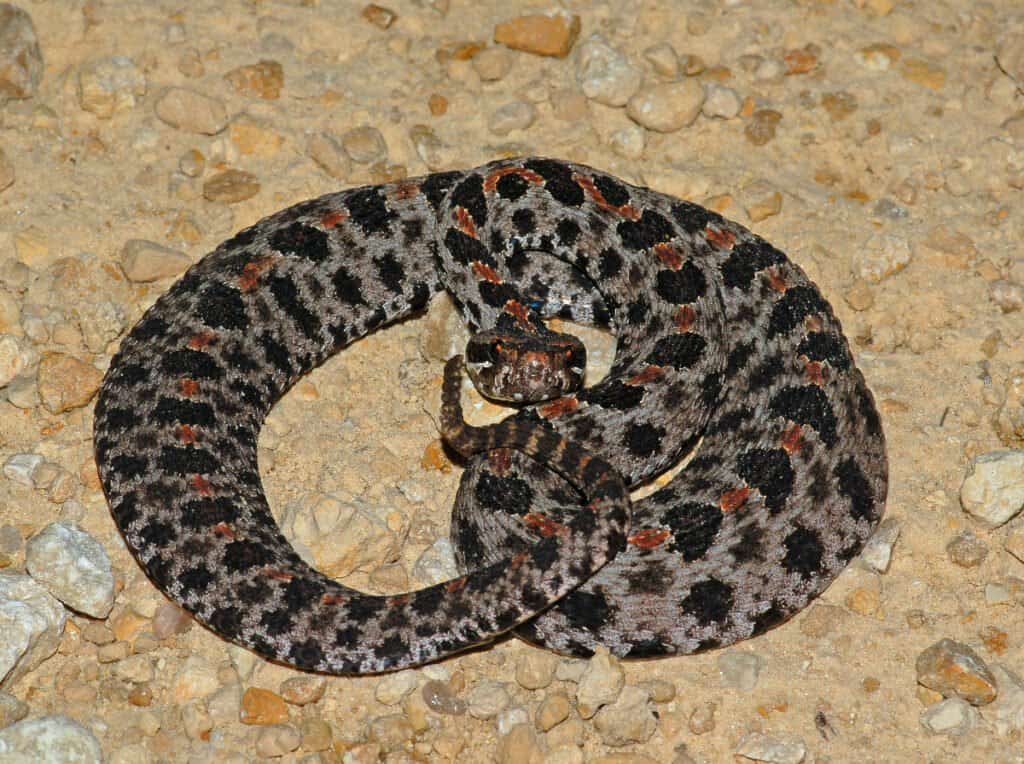
Gerald A. DeBoer/Shutterstock.com
Pygmy rattlesnakes are one of the few venomous snakes that inhabit urban areas. They are often found in yards, in flowerpots or in landscaping around homes, and in brush piles. These snakes may look harmless because of their very small size but they are venomous. They almost never are larger than 18 inches long, and most are just about 12 inches long.
Even though the pygmy is technically a rattlesnake they don’t actually rattle in most cases. Usually, they prefer to strike their pretty silently without warning, which makes them very dangerous in an urban environment. Always look for snakes before you start doing lawn or gardening work around your home in Louisiana. Because these snakes are very small a bite probably won’t kill you but the venom can cause some tissue damage and a lot of pain. Get medical help immediately if you are bitten by a pygmy rattlesnake.
Eastern Copperhead

Jeff W. Jarrett/Shutterstock.com
Eastern Copperheads inhabit mostly rocky areas of the state and the parts of the state that have the highest elevation. But if you spend a lot of time near the marshy areas of the state you might see them there as well. These venomous snakes are most active during fall and spring. During the hot months of July and August, they often are nocturnal so you can usually avoid them unless you are out at night camping, hiking, or fishing. They often don’t get bigger than about three feet. Eastern Copperheads have coloring that tends to blend in very well with their surroundings so you should be very careful of them. They strike without warning, and while a bit from an Eastern Copperhead probably won’t kill you it can be very painful.
Coral Snakes (Texas and Eastern)
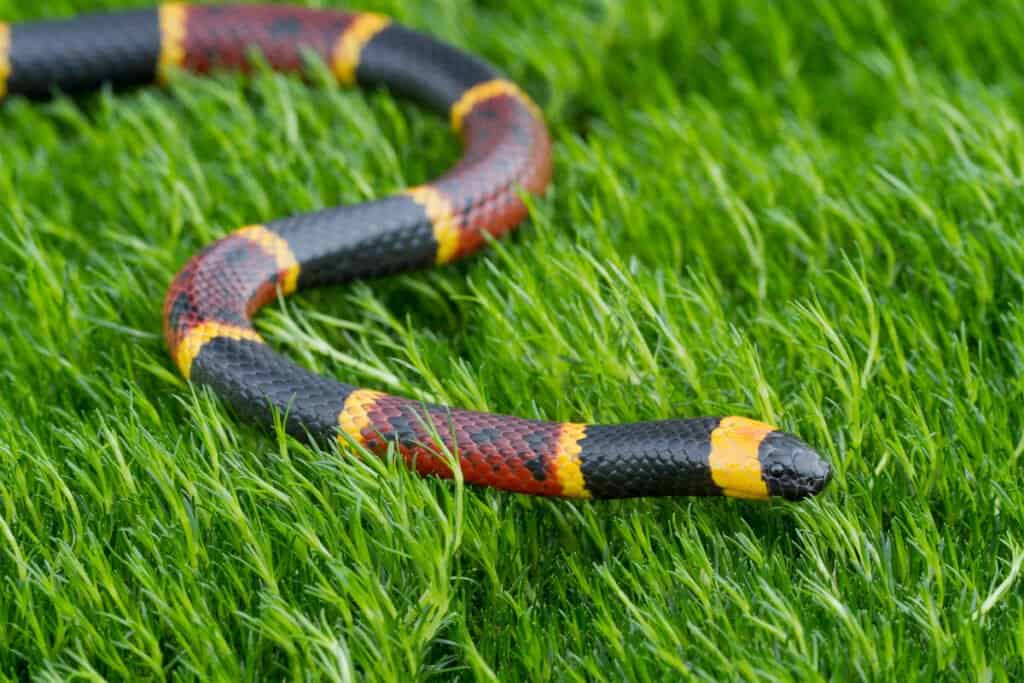
Mark_Kostich/Shutterstock.com
Coral snakes are recognized by their black heads and the black dots inside their bands. These colorful snakes don’t look that dangerous but they have a very powerful venom that can cause tissue damage and respiratory distress in just minutes. Thankfully, these colorful but dangerous snakes prefer to live mostly underground so it’s very rare for them to come into contact with humans.
The western half of Louisiana is home to the Texas coral snake while the eastern side is home ot the Eastern coral snake. The middle of Louisiana is likely free from coral snakes, but if you see a snake matching their coloring, be extremely careful!
Northern Cottonmouth (Water Moccasin)
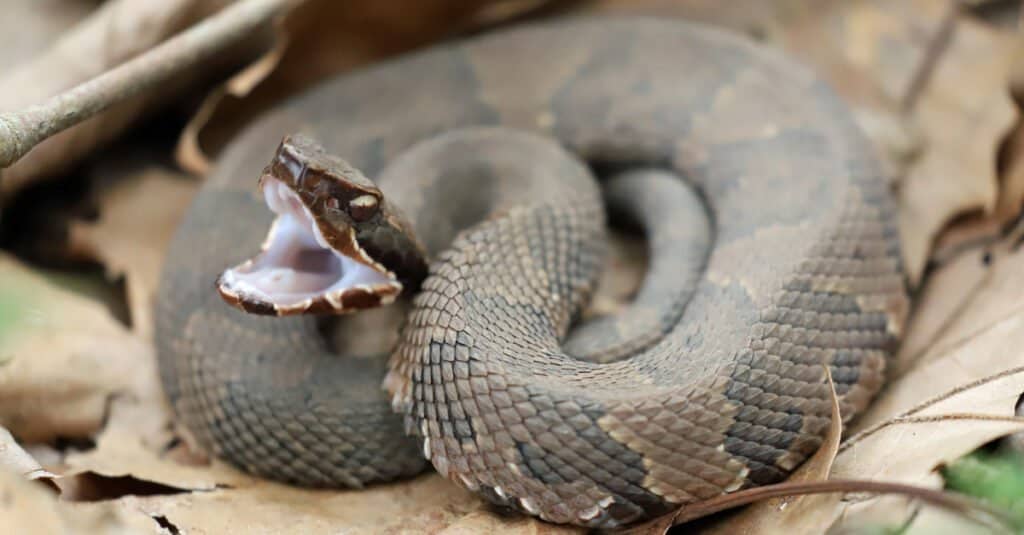
KF2017/Shutterstock.com
Northern Cottonmouth’s are the only aquatic snake in Louisiana that is venomous. But since so much of Louisiana is made of water or closer to water it be tough to find a place where they’re not. Northern Cottonmouth Water Moccasin snakes are known for showing their wide open mouth when they feel threatened. They will throw back their heads exposing their large white mouths before they strike. So if you see a flash of white get your arms and legs out of the area as fast you can.
The Complete List Of Snakes In Louisiana
There are many more types of snakes in Louisiana that aren’t covered here. Because Louisiana has such a unique climate and landscape it’s a paradise for snakes. If you love snakes be on the lookout for these types of snakes in Louisiana:
- Ball python (invasive)
- Banded water snake
- Black pine snake
- Brahminy blind snake
- Brown snake
- Canebrake rattlesnake
- Coachwhip
- Common garter snake
- Common water snake
- Copperhead
- Cottonmouth
- Diamondback water snake
- Diamondback rattlesnake
- Eastern hog-nosed snake
- Ribbon snake
- Eastern worm snake
- Eastern kingsnake
- Flat-head snake
- Glossy crayfish snake
- Graham’s crayfish snake
- Gray rat snake
- Harlequin coral snake
- Louisiana pine snake
- Milk snake
- Mississippi green water snake
- Mud snake (Eastern and Western)
- Orange-stried ribbonsnake
- Pine woods snake
- Prairie kingsnake
- Pygmy rattlesnake
- Racer
- Rainbow snake
- Red corn snake
- Red-bellied snake
- Ring-necked snake
- Rough earth snake
- Rough green snake
- Salt marsh snake
- Scarlet kingsnake
- Scarlet snake
- Slowinski’s corn snake
- Smooth earth snake
- Southeastern crowned snake
- Speckled kingsnake
- Tan racer
- Texas coral snake
- Rat snake
- Western ribbon snake
- Western worm snake
- Yellow-bellied water snake
More from A-Z Animals
.more-snake-card-image { max-height:140px !important; }
@media (min-width: 481px) {
.mobile-top-content {
display: none;
}
}
#mobileTopContentCTACarouselControls { overflow: hidden; text-overflow: ellipsis; white-space: nowrap; }
.mobile-top-content .more { color: #fff; }
.mobile-top-content a { color: #fff; text-decoration: underline; }
.mobile-top-content a:hover { color: #fff; text-decoration: underline; }
@media (max-width: 480px) {
.mobile-top-content {
background-color: #06a10b;
color: #fff;
text-align: center;
/*height: 60px;
padding-top:5px;*/
font-size:80%;
/* display: block; */
margin: 0px -30px;
}
}
It’s probably no surprise that Louisiana has many different types of snakes. Louisiana has an extensive network of wetland swamps where snakes thrive. The warm weather and abundance of water and woods create the perfect habitat for many different types of snakes. You should always be careful when you are out in nature in Louisiana because there is a high probability that you will run across some snakes while you are out fishing, hunting, or boating. Luckily only seven of the 50-plus different types of snakes in Louisiana are venomous. Always be careful when you’re around any snake though, even if it’s not a venomous snake. Even non-venomous snakes can give you a nasty bite.
The Most Common Snakes in Louisiana
Some of the most common non-venomous snakes in Louisiana are:
Brown Snakes (Dekay’s Brown Snake)

Jay Ondreicka/Shutterstock.com
Brown snakes are very small, they are typically under 16 inches long. But you can find them almost everywhere. In Louisiana, they live in both rural and urban areas and they are often found in potted plants or under leaf piles. If there are piles of vegetation in an area there are probably brown snakes under or near it. They also live in nursery plants, so if you live in an urban area and you buy potted plants look carefully because there will probably be a brown snake in there.
Common Garter Snake

iStock.com/randimal
As the name suggests these snakes are commonly found throughout the state. They have diamond-shaped heads and patterns of spots across their bodies which they display when they feel threatened. A Common Garter Snake will lower and flatten its head and spread out its body if it is feeling cornered or threatened so if you see a Common Garter Snake start to flatten out slowly back away and leave the area.
Eastern Hog-Nosed Snake

IHX/Shutterstock.com
The Eastern hog-nosed snake is another non-venomous snake that lives throughout Louisiana, although it prefers drier areas and isn’t usually found in wetlands. This snake looks pretty scary when you come across it but it’s non-venomous and it’s more scared of you than you are of it. Eastern hog-nosed snakes will look like they are going to bite if they feel threatened but it’s just a bluff. If you don’t back away immediately it will fall down and play dead until you leave the area.
Venomous (Poisonous) Snakes In Louisiana
There are only seven types of venomous snakes in Louisiana. That means you have a much higher chance of coming across a non-venomous snake than you do of running into a venomous snake. However, if you do spend a lot of time in the wet low-lying areas or in the forests you should always watch out for these venomous snakes in Louisiana:
Eastern Diamond Rattlesnake

iStock.com/NajaShots
The eastern diamondback rattlesnake is one snake that you definitely cannot miss despite the muted coloring it has. The eastern diamond back is the largest and heaviest snake in Louisiana. This snake can grow to be a whopping eight feet long, although most around six feet long. The eastern diamondback is mostly nocturnal and is most active just after dusk or before sunrise.
They tend to stick to drier areas like scrublands or woodlands although they make lurk on the edges of swamps and rivers. eastern diamondbacks have a distinctive black pattern on their faces and the pattern of diamonds down their backs that they get their name from. They can strike at prey that is several feet away from them very swiftly, so you should always stay far back from one of these snakes. If you hear the telltale rattle start and you see the snake start to rise up very slowly back up until you are out of striking distance.
Timber Rattlesnake

bradenjalexander/Shutterstock.com
Timber rattlesnakes inhabit forested areas, farms and agricultural areas, and lowland thickets across the entire state of Louisiana. They can get to be about five feet long and they have colorings that range from yellow-gray to black. Timber rattlesnakes are near the top of the list of the deadliest predators in Louisiana. They have extremely long and extremely sharp fangs. They also have the most concentrated venom of any of the poisonous snakes in the state. A Timber rattlesnake may not give you a lot of warning before striking. It’s an ambush hunter that prefers to strike unexpectedly. So when you hear a rattle assume you don’t have a lot of time and get out of the immediate vicinity immediately.
Pygmy Rattlesnake

Gerald A. DeBoer/Shutterstock.com
Pygmy rattlesnakes are one of the few venomous snakes that inhabit urban areas. They are often found in yards, in flowerpots or in landscaping around homes, and in brush piles. These snakes may look harmless because of their very small size but they are venomous. They almost never are larger than 18 inches long, and most are just about 12 inches long.
Even though the pygmy is technically a rattlesnake they don’t actually rattle in most cases. Usually, they prefer to strike their pretty silently without warning, which makes them very dangerous in an urban environment. Always look for snakes before you start doing lawn or gardening work around your home in Louisiana. Because these snakes are very small a bite probably won’t kill you but the venom can cause some tissue damage and a lot of pain. Get medical help immediately if you are bitten by a pygmy rattlesnake.
Eastern Copperhead

Jeff W. Jarrett/Shutterstock.com
Eastern Copperheads inhabit mostly rocky areas of the state and the parts of the state that have the highest elevation. But if you spend a lot of time near the marshy areas of the state you might see them there as well. These venomous snakes are most active during fall and spring. During the hot months of July and August, they often are nocturnal so you can usually avoid them unless you are out at night camping, hiking, or fishing. They often don’t get bigger than about three feet. Eastern Copperheads have coloring that tends to blend in very well with their surroundings so you should be very careful of them. They strike without warning, and while a bit from an Eastern Copperhead probably won’t kill you it can be very painful.
Coral Snakes (Texas and Eastern)

Mark_Kostich/Shutterstock.com
Coral snakes are recognized by their black heads and the black dots inside their bands. These colorful snakes don’t look that dangerous but they have a very powerful venom that can cause tissue damage and respiratory distress in just minutes. Thankfully, these colorful but dangerous snakes prefer to live mostly underground so it’s very rare for them to come into contact with humans.
The western half of Louisiana is home to the Texas coral snake while the eastern side is home ot the Eastern coral snake. The middle of Louisiana is likely free from coral snakes, but if you see a snake matching their coloring, be extremely careful!
Northern Cottonmouth (Water Moccasin)

KF2017/Shutterstock.com
Northern Cottonmouth’s are the only aquatic snake in Louisiana that is venomous. But since so much of Louisiana is made of water or closer to water it be tough to find a place where they’re not. Northern Cottonmouth Water Moccasin snakes are known for showing their wide open mouth when they feel threatened. They will throw back their heads exposing their large white mouths before they strike. So if you see a flash of white get your arms and legs out of the area as fast you can.
The Complete List Of Snakes In Louisiana
There are many more types of snakes in Louisiana that aren’t covered here. Because Louisiana has such a unique climate and landscape it’s a paradise for snakes. If you love snakes be on the lookout for these types of snakes in Louisiana:
- Ball python (invasive)
- Banded water snake
- Black pine snake
- Brahminy blind snake
- Brown snake
- Canebrake rattlesnake
- Coachwhip
- Common garter snake
- Common water snake
- Copperhead
- Cottonmouth
- Diamondback water snake
- Diamondback rattlesnake
- Eastern hog-nosed snake
- Ribbon snake
- Eastern worm snake
- Eastern kingsnake
- Flat-head snake
- Glossy crayfish snake
- Graham’s crayfish snake
- Gray rat snake
- Harlequin coral snake
- Louisiana pine snake
- Milk snake
- Mississippi green water snake
- Mud snake (Eastern and Western)
- Orange-stried ribbonsnake
- Pine woods snake
- Prairie kingsnake
- Pygmy rattlesnake
- Racer
- Rainbow snake
- Red corn snake
- Red-bellied snake
- Ring-necked snake
- Rough earth snake
- Rough green snake
- Salt marsh snake
- Scarlet kingsnake
- Scarlet snake
- Slowinski’s corn snake
- Smooth earth snake
- Southeastern crowned snake
- Speckled kingsnake
- Tan racer
- Texas coral snake
- Rat snake
- Western ribbon snake
- Western worm snake
- Yellow-bellied water snake






